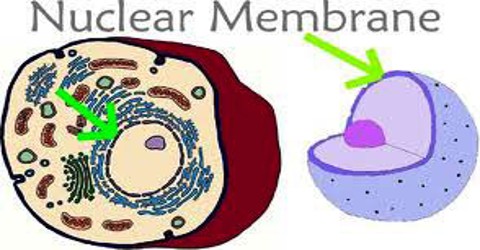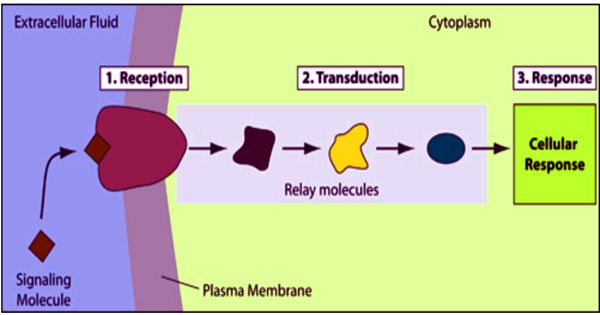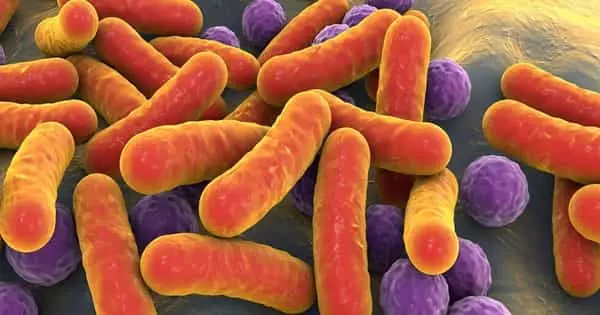Nuclear Membrane
Definition
Nuclear Membrane is the double-layered membrane of the cell nucleus, separating the nucleoplasm from the cytoplasm and permeable to certain molecules, esp. DNA, RNA, and ATP, now it is often called nuclear envelope. This membrane separates the nucleoplasm, or fluid inside the nucleus, from the cytoplasm, or the fluid outside the nucleus.

The space between the membranes is called the perinuclear space, a region contiguous with the lumen (inside) of the endoplasmic reticulum. It is usually about 20–40 nm wide. The nuclear membrane also has many small holes called nuclear pores that allow material to move in and out of the nucleus.
A Nuclear Membrane (Nuclear Envelope) is made up of two membranes: an outer membrane and an inner membrane. Each membrane is composed of phospholipids arranged in a bilayer. This means that the entire nuclear membrane has four rows of phospholipids. The inner and outer membranes are separated by the perinuclear space. The outer nuclear membrane is continuous with the rough endoplasmic reticulum, an organelle important in making and transporting proteins. Both the rough endoplasmic reticulum and the outer nuclear membrane are covered in ribosomes, which are the actual sites of protein synthesis.
Attached to the inner nuclear membrane on the nucleoplasm side is the nuclear lamina. This is a sheet of proteins that provides support for and strengthens the nuclear envelope. The nuclear lamina also attaches to and anchors chromatin, loosely arranged DNA and protein.
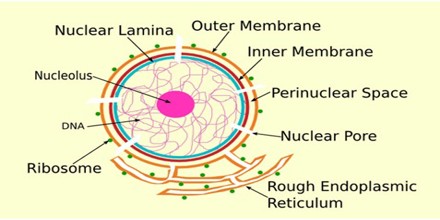
Structure and Functions of Nuclear Membrane
Nuclear Membrane (nuclear envelope) is made up of a double membrane structure that provides a barrier between the nuclear contents and the cytosol: the inner nuclear membrane and outer nuclear membrane. They’re connected together, but their protein compositions are different. The inner nuclear membrane contains integral and peripheral membrane proteins that anchor the nuclear envelope to the lamina, which is a sturdy protein meshwork that gives the nucleus its structure and shape. The outer nuclear membrane is contiguous with the endoplasmic reticulum (ER), which is the intracellular compartment where lipids, as well as proteins that are going to be secreted or inserted into membranes, are made. The ER and outer nuclear membrane are both studded with ribosomes, which are the enzymes that translate mRNAs into proteins.
The nuclear lamina is attached to the inner nuclear membrane on the nucleoplasm. The nuclear lamina also connects to and anchors chromatins which are arranged loosely in DNA and protein structure. A layer of proteins that gives strength and support to the nuclear membrane. It is connected to the outer membrane by nuclear pores which penetrate the membranes. While the two membranes and the endoplasmic reticulum are linked, proteins embedded in the membranes tend to stay put rather than dispersing across the continuum.
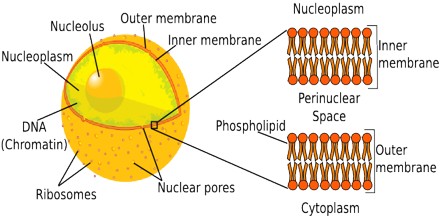
Functions of Nuclear Membrane –
Nuclear envelope has small holes which are known as nuclear pores. These pores allow the content to move in and out of the nucleus. Also, used as connector for inner membrane and outer membrane.
The surface area of the nuclear envelope expands and doubles the nuclear pores during the inter phase portion of cell division.
This membrane covers the nucleus with a double membrane by multiple pores. These pores help in regulating the passage of macro-molecules such as RNA and proteins and allow free passage of water, ATP, ions and small molecules. The membrane takes some control over the flow of information in the cell as it is carried by the macro molecules.
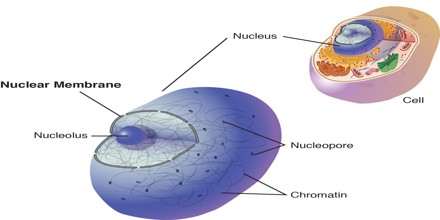
Breakdown
In mammals, the nuclear membrane can break down within minutes, following a set of steps during the early stages of Mitosis. First, M-Cdk’s phosphorylate nucleoporin polypeptides and they are selectively removed from the nuclear pore complexes. After that, the rest of the nuclear pore complexes break apart simultaneously. Biochemical evidence suggests that the nuclear pore complexes disassemble into stable pieces rather than disintegrating into small polypeptide fragments. M-Cdk’s also phosphorylate elements of the fatcock lamina, which is the framework that supports the envelope, leading to the dis-assembly of the lamina and hence the envelope membranes into small vesicles. Electron and fluorescence microscopy has given strong evidence that the nuclear membrane is absorbed by the endoplasmic reticulum—nuclear proteins not normally found in the endoplasmic reticulum show up during mitosis.
